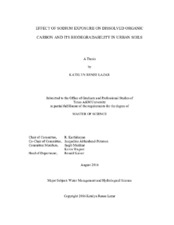| dc.description.abstract | As climate change progresses, carbon sequestration is becoming an increasingly important strategy for long term carbon storage in soil. Adding to and preserving this carbon storage is crucial for the development of future management strategies that maintain this natural process. This study examines the effects of sodium in urban soils on water extractable dissolved organic carbon (DOC) and organic nitrogen (DON) and biodegradable DOC (BDOC) from 1) de-icing salts, 2) irrigation water, and 3) deposition of oceanic aerosols. Evaluation of the effects of time of soil exposure to sodium from the different sources was a major objective of this study. Urban soil samples were collected from Chicago, IL (n=36), Galveston, TX (n=36), and Bryan- College Station, TX (n=36). Soil samples were extracted with a 1:10 soil/deionized water ratio and DOC, DON, BDOC, EC, pH, alkalinity, and soil chemistry (Ca, Mg, K, Na, Fe, Zn, Mn, B, S, Cu) was measured.
Univariate analysis of variance determined that sodium source had a significant effect on all major dependent variables tested, which included %BDOC (p < 0.001), DOC (p = 0.03), DON (p < 0.001), and specific UV absorbance (SUVA254) (p < 0.001). Soil exposure time to sodium had a significant effect on water extractable DOC (p < 0.001) and DON (p < 0.001) but not on %BDOC (p = 0.13) or SUVA254 (p = 0.25). %BDOC and SUVA254 did not exhibit a significant relationship; however, when %BDOC and SUVA254 were analyzed by city a significant relationship existed for all three cities. There was a significant positive relationship between DOC concentration and SUVA254 across all three cities (p < 0.001, r^2 = 0.33).
The implications of this study can help predict water extractable DOC and DON and %BDOC loss resulting from increased soil sodium accretion from deicing salts, irrigation, and atmospheric deposition. Increased accretion of soil sodium could have large scale implications on carbon storage and potentially offer an explanation for the increased DOC concentrations observed in urban streams. | en |


